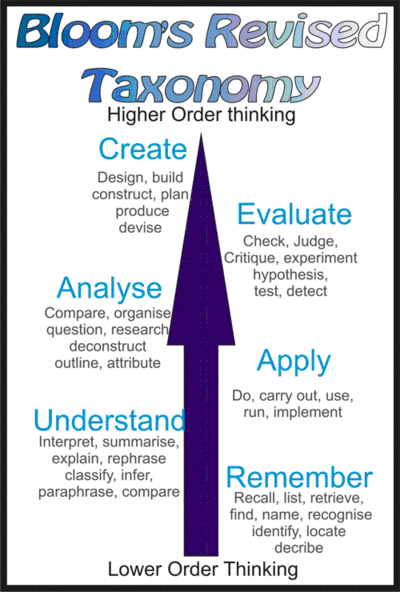

Welcome to Math Year 6!
Congraduations in completing the unit of work on fractions, decimals, percentages and the connections between them; as well as investigating positive and negative numbers in our everyday contexts.
We are going to investigate Dr Edward de Bono's Six Thinking Hats in relation to our mathematical knowledge about rational numbers. The Six Thinking Hats allows us to use our thinking skills to develop a greater understanding about different mathematic concepts.
This is supported by Blooms revised Taxonomy as we identify lower level thinking skills moving to higher order thinking.
Lets begin, and challenge ourselves to move from lower level thinking to higher order thinking.
Mission information
Group work:
Form six groups of 3-4, and work through the activities provided.
As you approach the activities consider the ways you are using Dr Edward de Bono's Six Thinking Hats as you develop your thinking skills.

White thinking hat: calls for information known or needed. "The facts, just the facts."

Yellow Thinking Hats: symbolizes brightness and optimism. You can explore the positives and probe for value and benefit.

Green Thinking Hat: focuses on creativity, possibilities, alternatives and new ideas. It is an opportunity to express new concepts and new perceptions - lateral thinking could be used here.

White thinking hat: calls for information known or needed. "The facts, just the facts."
NSW BOS Curriculum Links: Stage 3: Year 6
Mathematics and English
Mathematics Strand: Numbers and Algebra; Sub-strand: Fractions and Decimals 2
Outcomes for mathematics: Students will compare, order and calculate with fractions, decimals and percentages (MA3-7NA).
Content: (ACMNA131) (BOS NSW, 2012)
Working Mathematically: Students will: describe and represent mathematical situations in a variety of ways using mathematically language (MA3-1WM); select and applies appropriate problem-solving strategies, including the use of digital technologies, in undertaking investigations (MA3-2WM); and gives a valid reason for supporting one possible solution over another (MA3-3WM)
English Outcomes: Skills:
Speaking and listening (communicating): Students will communicate effectively for a variety of audiences and purposes using increasingly challenging topics, ideas, issues and language forms and features (EN3-1A).
Reading and Viewing: Students use an integrated range of skills, strategies and knowledge to read, view and comprehend a wide range of texts in different media and technologies (EN3-3A).
Writing and representing: Students compose, edit and presents well-structured and coherent texts (EN3-2A).
Grammar, punctuation and vocabulary: Students uses knowledge of sentence structure, grammar, punctuation and vocabulary to respond to and compose clear and cohesive texts in different media and technologies (EN3-6B).
Spelling: Students can draw on appropriate strategies to accurately spell familiar and unfamiliar words when composing texts (EN3-4A).
Thinking imaginatively and creatively: Students: think imaginatively, creatively, interpretively and critically about information and ideas, and identify connections between texts when responding to and composing texts (EN3-7C).
Expressing themselves: Students identify and consider how different viewpoints of their world, including aspects of culture, are represented in texts (EN3-8D). (BOS NSW, 2012)


